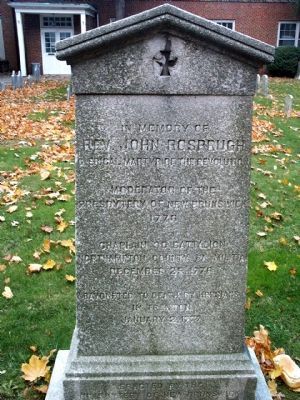
On the 29th of July 1775 General George Washington authorized clergy to serve with the troops and thus was born the Chaplain Corps of the United States Army. Since that day, chaplains have served with distinction in peace time as well as in war. Men and women of all faiths have answered not only the call of God, but the call of their country to serve alongside soldiers, sailors, and marines in all situations. This is the story of one such chaplain.
John Rosbrugh was born in 1714 in Northern Ireland and came to America with several members of his family and settled in New Jersey. He attended the College of New Jersey, now Princeton University, and in 1762 he was licensed to preach by the New Brunswick Presbytery. Two years later he was called to pastor congregations in Greenwich, Oxford, and Mansfield Woodhouse in Western New Jersey and was ordained to the ministry in the Presbyterian Church.
The main source of information to the residence of communities in the Colonies was from the pulpit. Many preachers used the time to stir up their congregations to fight for their rights that were being reduced each day by Parliament. There were fiery sermons delivered from pulpits up and down the coast by what became known as the “Black Robed Regiment.” American patriotism and theology were woven together to show that Liberty and Freedom were gifts given to people by God and, in the words of the Declaration of Independence these rights were “unalienable.”
So moved were the members of Rev. Rosbrugh’s congregations they formed a regiment and asked him to lead them. The thought he would go to war with them as their chaplain but they asked him to in fact, be their commander. He took the head of regiment, slung his musket over his shoulder, and led them to join up with General Washington and the Continental Army in Philadelphia.
After their arrival in Philadelphia it was decided that Rev. Rosbrugh was better suited to the role of chaplain and he was replaced by Captain John Hays. At this time in the history of the Chaplain Corps the Army Chaplain was not provided a uniform, he would have worn the common black clothing of a preacher, he did however hold the rank of major and received pay of thirty-three and half dollars per month for his service.
It is important to note that at this point in time in history, Presbyterian minsters were especially hated by the British troops and if they were captured they would suffer the cruelest treatment.
On the afternoon of January 2 1777 General Washington decided to take Trenton for the second time, the battle is known as the Battle of Assunpink Creek, and Rev Rosbrugh’s company was involved in this battle. When the attack began he was dining at a public house when he heard the alarm sound. Leaving the building he found that his horse had been taken and he was suddenly confronted by a company of Hessian Troops. He raised his arms in surrender but he was recognized as a Presbyterian minister and he was bayonetted to death on the spot. He was stripped of all of his clothes and left naked in the snow.
William Dwyer, in his book The Day is Ours! An Inside View of the Battles of Trenton and Princeton, November 1776-January 1777 [1] he suggests that Rev. Rosbrugh was so brutally killed because he was mistaken for the Rev. John Witherspoon whom the British troops had burned in effigy not long before this attack took place.
Captain Hayes herded of the death of his chaplain went to find his body. He found him in the spot where he had been killed and quickly buried him there. The next day his body was moved by fellow Presbyterian minister George Duffield and was buried in the Presbyterian Church graveyard in Trenton.
Although it is believed he still lies in the grave he was placed in after his death there is some uncertainty to the exact location. His wife, who died in 1809, is buried in a cemetery in East Allen Township and the inscription on her stone indicates that he is buried alongside her.
Was he a victim of mistaken identity? Was he in the wrong place at the wrong time? No one knows for certain. What is known is that Chaplain Rosbrugh was the first US Chaplain to be killed in battle. He died, as so many others did, a martyr for the cause of freedom.
Chaplains continue to serve today in all branches of the US military and bring comfort to all in some of the most difficult situations. One of those was Chaplain (MAJ) Henry Timothy “Tim” Vakoc a Roman Catholic priest who died of wounds received when his Humvee was struck by an IED. Chaplain Vakoc is the only US Chaplain to die from wounds received in the Iraq war.
[1] William M. Dwyer, The Day is Ours! An Inside View of the Battles of Trenton and Princeton, November 1776-January 1777 (Rutgers University Press, New Brunswick, NJ, 1998) p. 323
